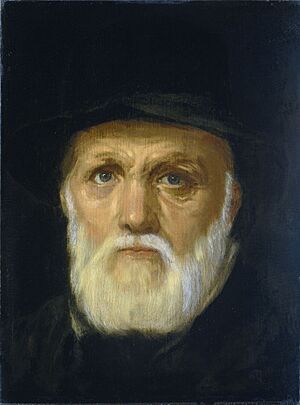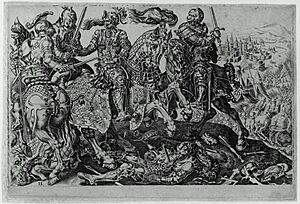Dirck Coornhert facts for kids
Quick facts for kids
Dirck Coornhert
|
|
|---|---|

Portrait by Cornelis van Haarlem
|
|
| Born |
Dirck Volckertszoon Coornhert
1522 |
| Died | 29 October 1590 (aged 68) |
| Other names | Theodore Cornhert |
| Known for | Writing, philosophy, theology, engraving |
| Movement | Humanism |
Dirck Volckertszoon Coornhert (1522–29 October 1590), also known as Theodore Cornhert, was a Dutch writer, thinker, translator, and artist. He was also involved in politics and religious discussions. Many people consider Coornhert to be a very important figure in the Dutch Renaissance for his scholarly work.
Contents
Dirck Coornhert's Early Life and Art
Dirck Coornhert was the youngest son of Volckert Coornhert, a cloth merchant from Amsterdam. As a child, he spent some years living in Spain and Portugal. When he returned home, he married Cornelia Simons in 1539. This marriage upset his father, and Dirck did not receive an inheritance.
Coornhert was only seventeen, and Cornelia was twelve years older. For a short time, he worked for Reginald, the count of Brederode, at his castle. Soon after, in 1541, he bought a house in Haarlem, his wife's hometown.
Becoming an Engraver
While living in Haarlem, Coornhert was inspired by the artist Maarten van Heemskerck. Heemskerck had just returned from Italy and his artwork was very impressive. Coornhert learned how to become an engraver on copper. He worked with Heemskerck to create many popular prints.
Coornhert's Political and Literary Work
In 1552, Coornhert learned Latin. This allowed him to translate important works from famous Roman writers like Cicero and Seneca the Younger. His 1562 translation of the first twelve books of Homer's Odyssey was one of the first major poems of the Dutch Renaissance.
Involvement in the Dutch Revolt
Coornhert became a secretary for the city of Haarlem in 1562. He also served as a secretary for the city's leaders (called burgomasters) in 1564. He became deeply involved in the Dutch Revolt, which was a fight against Spanish rule. In 1566, he helped write an important statement for William the Silent, who was a key leader in the revolt.
In 1568, Coornhert was put in prison in the Hague. He managed to escape to Cleves, where he continued to support himself through his art. He was called back in 1572 and briefly served as a secretary for the Dutch Republic. However, he did not like violence, so he returned to Cleves. William the Silent continued to use his skills as a writer and advisor.
Coornhert wrote a book called "Boeventucht" (which means "Discipline of Rogues"). In this book, he explored the reasons why people commit crimes. He also suggested more kind ways to punish and help people improve.
Coornhert's Religious Views
Coornhert was also well-known for his ideas about religion. When he was 30, he became very interested in theology, which is the study of religious beliefs. He wanted to read the works of St. Augustine, so he began to study Latin.
He often debated with both Catholics and Reformers. He believed that both groups needed to change. Coornhert thought that true religious leaders should be directly inspired by heaven. Until such leaders appeared, he suggested that all churches should unite in a simple, open community. Coornhert strongly supported tolerance and was against punishing people with death for their religious beliefs.
He did not belong to any single religious group. He even criticized the Heidelberg Catechism, which was a very important religious text in the Dutch Republic. Jacobus Arminius, a theologian who was asked to argue against Coornhert, was actually convinced by Coornhert's ideas.
Coornhert's Students
According to the Netherlands Institute for Art History (RKD), some of Coornhert's students who became artists were Hendrick Goltzius, Philip Galle, and Cornelis Cort.
Key Works by Coornhert
Besides the 1566 statement for the Dutch Revolt, Coornhert wrote many other important works. He wrote a paper arguing against the death penalty for people with different religious views. He also wrote a pamphlet that defended the rebellion of the United Provinces.
He wrote a foreword for a Dutch grammar book and several poems. Some people believe he wrote the popular song, Wilhelmus van Nassouwe, which is now the national anthem of the Netherlands. However, others think Philip van Marnix wrote it.
In 1586, he created his most famous work, the Zedekunst ("Art of Ethics"). In 1587, he published "Boeventucht," his essay about how to deal with criminals.
When he passed away in 1590, his Dutch translation of the New Testament was not finished. All of his writings, both prose and poetry, were published together in 1630 in three volumes.
Isaac D'Israeli, a famous writer, called Coornhert "one of the fathers of Dutch literature, and even of their arts."
Famous Quotes
- "Each wants to dictate another's creed ... This is done by those who formerly taught that such things do not become the Christian."
- "Rest Elsewhere" (This was his personal motto).
- "...a voluntary crowbar to the murderous prison of conscience" (He said this about himself).


